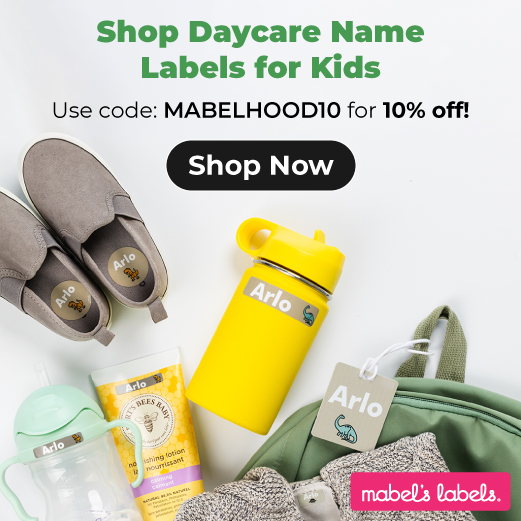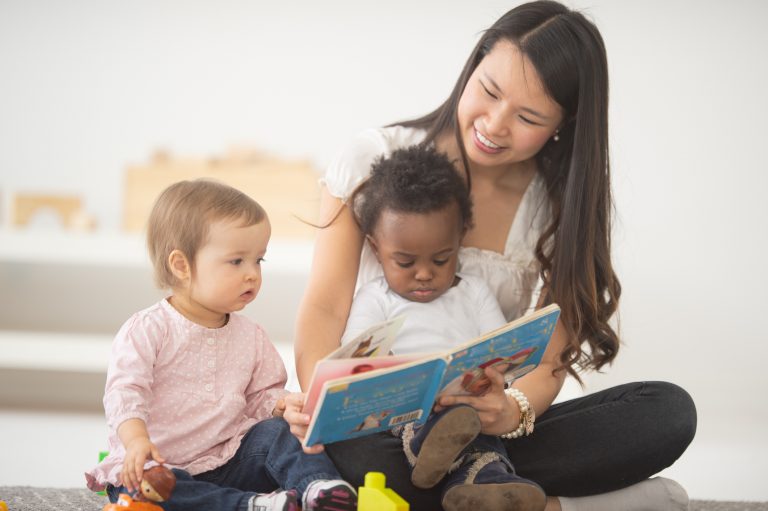The end of maternity leave is a very sad time for many mothers. It can make you feel sick with a mix of emotions: guilt, anxiety, sadness, and fear. It’s also liberating for some moms, those who feel the need to get their life and career moving again. Moms can be excited to have new challenges outside of the home. However you feel about it, we can all agree that the logistics are complex. From packing to pick-up times, it’s not an easy transition to make. Nobody can take the anxiety away, but we can help ease the logistical challenge and steer you in the right direction with getting more organized for the next step.
Why Labeling for Daycare is Essential
This is a question we used to get quite often at Mabel’s. Today, in post-pandemic life. We want to avoid germy mix-ups. This is, by far, the number one reason for labels. We know these days that a runny nose can lead to many days at home, and (after heading back to work especially) this is just feasible for many parents.
Secondly, the daycare will require it. And lastly, you’ve spent a lot of money on your kid’s items, and you don’t want them getting lost or going home to the wrong house.
Why You Should Label Daycare Items:
1. Lost daycare items will cost you!
When you’re considering packing for daycare, you are considering investing a lot of time and money into extra clothing, shoes, pacifiers, blankets, bottles, stuffies, diapers, wipes, and more. You want to ensure your baby has everything they’ll need to be comfortable when away from you. You also want to ensure that your child’s onesies don’t get mixed up with another’s and that the right stuffy gets tucked in with them at nap time. This can be a significant investment (on top of all your daycare costs), and replacing lost items adds up even faster. So, when daycare asks that you label your baby’s things, it’s not just to help them; it’s for your financial benefit, too!
2. Germy mix-ups lead to sick babies
It’s important to understand that labeling for daycare isn’t just about mixed-up and misplaced items. The past few years have taught us so much about the importance of keeping our kids safe and our childcare workers safe. They’re essential workers, and we must ensure they get a secure environment. 
Germs can cause a lot of stress to parents these days.
One of the moms’ biggest fears during the first few months of daycare is the new germs their kids are picking up. You went from experiencing very few colds to not knowing where one cold ends and the next one begins. Trying to avoid daycare germs feels like an exercise in futility, but as moms, we want to do everything we can to protect our little ones from being miserable with sniffles (a rash, a flu, or a stomach bug). Labeling is an easy way for the daycare provider to quickly look at and check the name on a pacifier or sippy cup before handing it to your baby. It’s the very first step in avoiding those unwanted germs. It’s simple and easy, yet crucial.
3. It’s a matter of safety for kids and staff
Name labels for baby bottles are essential to the daycare centers’ health and hygiene practices. This isn’t something you want to be negligent with. Babies and toddlers are highly susceptible to illness. It’s crucial as parents that you do your part to ensure that the daycare center can implement the policies and procedures needed to keep your child safe.
Here are a few things to consider when starting a daycare and labeling bottles:
- Consult with your daycare and ensure you make them aware that your child’s nutritional needs are being met. Double-check the procedure to ensure this happens (whether through breast milk, cow’s milk, or formula). This will help you decide if you need date-stamped labels or name labels for whatever nourishment you’re sending. Open communication is critical to the feeding procedure running safely and smoothly and will also help ease your mind.
- Most commonly, bottles must be labeled with name/date and time. The best baby bottle labels have your baby’s name and a spot to write and wipe off dates. Make sure to get ones that are dishwasher and sanitizer-safe! Those are precisely what your daycare center needs to ensure they’re adhering to their procedures on feeding your babies. Plus, it will make the process easier for you and more organized for everyone involved.
How to Label Common Daycare Items:
So, what do you need to label when packing your little one’s bag for daycare? The short answer: Everything that goes to daycare must have a label. Everything. To help you break it down, here’s a sample daycare packing list and some instructions on how you can keep everything identified:
- Diapers, Diaper Cream, and Wipes: Don’t worry, you don’t need to label individual diapers! The daycare will keep them in your child’s cubby or diaper bag (hence why that should be labeled). However, it is a good idea to put some identification on your wipes and diaper cream. You’re guaranteed the same ones as someone else in the center.
- Diaper Bag or Backpack: You’ll need to send a bag to hold all your child’s items in the daycare center. Attach a personalized tag to the loop or zipper so the center knows which cubby the bag should live in and always has a bag to corral your things.
How to Label Baby and Toddler Clothing:
- Extra Clothing: You’ll need to send a spare change of clothes in case of any accidents or spills. Invest in a set of children’s name labels for clothes (there are peel-and-stick or iron-on varieties available), and make sure that every item of clothing is labeled. It’s hard for a busy caregiver to distinguish whose sock or onesie is whose!
- Outerwear: Mitts are like socks; you’ll always end up with strays! Like your kid’s indoor spare clothes, washable clothing labels are the best way to label all clothing, including outdoor accessories like mittens and hats. There are peel-and-stick or iron-on varieties, and they’ll stay on through the washer and dryer, so you don’t have to keep re-labeling them repeatedly.
- Indoor Shoes: Believe it or not, shoes are easily lost in the busy in-and-out shuffle at daycare. Ensure the inside of your little one’s shoes are labeled so they don’t end up in the lost and found pile.
How to Label Your Baby’s Personal Items:
- Pacifiers: Depending on the type of pacifier, you should be able to fit a small waterproof label on the front of it. Pacifiers differ so significantly that it’s difficult to say what will work best for your exact one. TIP: If you’re trying to label a silicone pacifier, no adhesive labels will stay on it, so you’d be better off attaching it to a pacifier clip and labeling that.
- Sippy Cups and Bottles: Sippy cups and bottles are some of the most commonly lost items, so labeling them is a priority. They’re also a big culprit of viruses spreading, so make sure whatever name label you stick to them is prominent and highly visible! A dishwasher-safe label or personalized silicone bottle band is critical for these items.
- Pumped Milk/Formula: Whether you’re sending breast milk or formula to childcare, your daycare will request that it be well-labeled. If you’re sending a recipe, don’t forget to label the container, lid, and even the little scoop (you don’t want it to go missing to avoid cross-contamination).
Head back to work feeling prepared!
In post-pandemic life, keeping a safe environment for staff, babies, and their families is more important than ever. It can be fearful, but with some organization and preparation, you can return to work feeling ready and excited.
Labeling your kid’s stuff is a simple and easy task that can significantly benefit how smoothly your daycare experience will go. With all the stress and anxiety surrounding your maternity leave ending, anything you can do to help with the organization will be beneficial.
The more organized you feel, the more you can ease your worries. Most importantly, above all that is good and labeled, go easy on yourself! Daycare drop-off is complicated, emotional, traumatizing, and an internal battle with yourself and your guilt. And remember, it’s okay to ugly cry.
How to Label for Daycare: Key Takeaway’s
-
Label everything: Every item sent to daycare needs to have a label—diapers, clothes, pacifiers, bottles, etc.
-
Choose durable labels: Ensure labels are waterproof, washable, and dishwasher-safe to withstand daily wear and tear.
-
Prioritize visibility: Labels should be clear and easy to spot for daycare staff to identify items quickly.
-
Check daycare requirements: Make sure you’re labeling in line with your daycare’s specific guidelines for feeding and hygiene.

